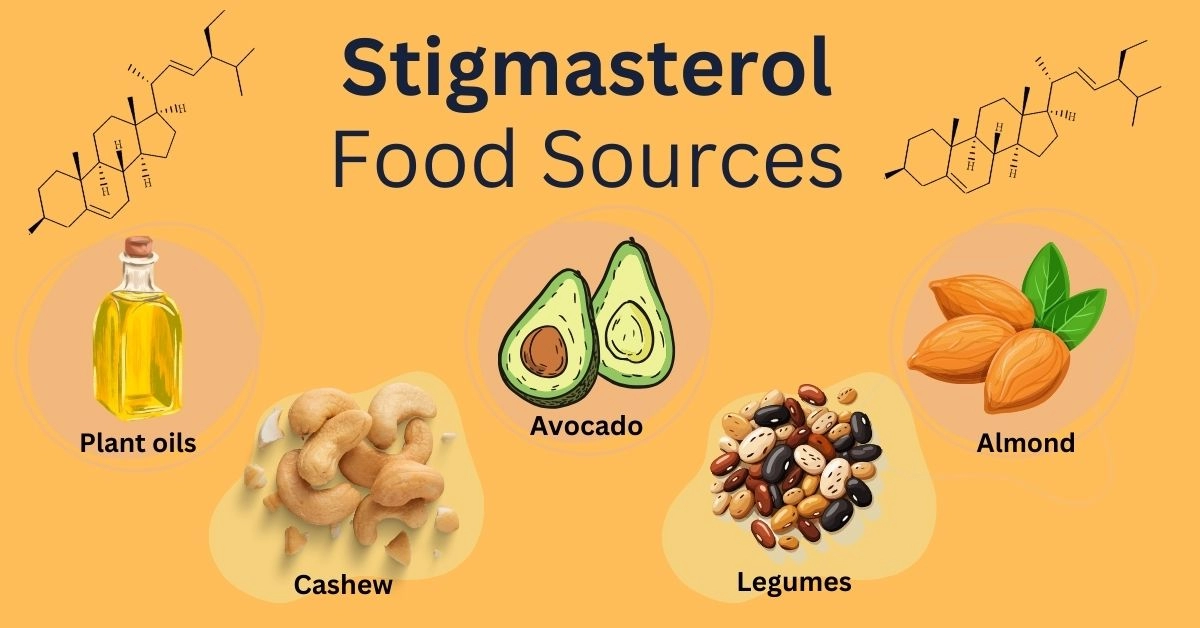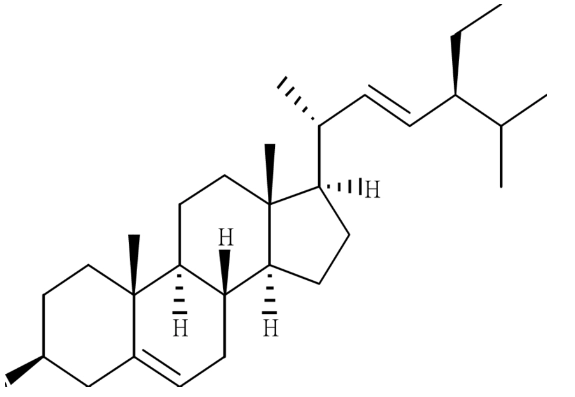Stigmasterol - Structure, Food Sources, Supplements, and Health Benefits

Summary
Stigmasterol is a natural phytochemical - phytosterol - widely found in plant sources like soybean oil. It belongs to the family of sterols, similar to cholesterol, but with unique properties that positively affect lipid metabolism, cardiovascular health, and certain cancer treatments. Stigmasterol exhibits anti-inflammatory, antioxidant, and cholesterol-lowering effects. It also plays a role in reducing the risk of cardiovascular disease and cancer.
Stigmasterol influences cellular processes such as apoptosis, cell proliferation, and oxidative stress. Its molecular structure, which includes double bonds and a unique side chain, is key to its effectiveness in reducing cholesterol absorption and managing lipid metabolism. Research suggests it may have the potential to treat cancers, including ovarian and breast cancers, by influencing cell growth and death.
Table of contents
- Introduction
- Structure and Properties
- Metabolism
- Stigmasterol Supplements and Dosage
- Foods Rich in Stigmasterol
- Health Benefits of Stigmasterol
- Cholesterol-Lowering Effects
- Antioxidant and Anti-Inflammatory Effects
- Anticancer Potential
- Stigmasterol and Osteoarthritis
- Neuroprotective Effects
- Antifungal and Antiparasitic Effects
- References
Introduction
Stigmasterol, a plant-derived sterol, is one of the key compounds found in various plant oils, including soybean oil. Like other phytosterols, it plays a role in maintaining healthy cholesterol levels and supporting overall lipid metabolism. Structurally, it is similar to cholesterol but differs due to specific double bonds and a distinctive side chain that gives it unique biological functions.
This article will explore stigmasterol's structure, supplementation, food sources, effects on cholesterol and lipid metabolism, and role in cancer prevention and cardiovascular health.
Structure and Properties
Stigmasterol has the molecular formula C29H48O and is a sterol belonging to the phytosterol family. It features a stigmasta-5,22-dien-3 structure, with two key double bonds in the steroid backbone (1). These structural differences from cholesterol, particularly the presence of an unsaturated side chain, contribute to its role in reducing cholesterol absorption in the intestines and lowering plasma cholesterol levels.

Stigmasterol is lipid-soluble, found in foods rich in fatty acids, and is often extracted using solvents like chloroform and methods like gas chromatography (2).
It has been studied for its stability and interaction with lipid bilayers, which is crucial in maintaining plasma membrane integrity in cells (3).
Metabolism
Once ingested, stigmasterol is absorbed in the intestines and undergoes metabolism, primarily in the liver, where it participates in complex processes related to lipid metabolism. Once in the liver, stigmasterol undergoes hydroxylation and other modifications, resulting in metabolites that are excreted via bile (4). It influences the biosynthesis of key compounds involved in cellular function. Studies show stigmasterol’s ability to reduce LDL cholesterol levels without affecting HDL cholesterol, making it beneficial for overall cardiovascular health (5).
Stigmasterol Supplements and Dosage
Stigmasterol supplements come in various forms. One common type is capsules or softgels, which are easy to swallow and offer precise dosages of stigmasterol. These are often favored for their convenience and portability. Powdered forms are also available, allowing users to mix the supplement into smoothies, shakes, or other beverages. This type is ideal for those who prefer to integrate supplements into their daily meals. Some brands also offer blended supplements, combining stigmasterol with other plant sterols or vitamins to enhance its health benefits.
The U.S. Food and Drug Administration (FDA) recommends consuming at least 0.65 grams of phytosterols, including stigmasterol, per serving twice a day with meals, for a total daily intake of at least 1.3 grams, to help lower the risk of heart disease (6).
This should be part of a diet low in saturated fat and cholesterol. For adults with high cholesterol, the National Cholesterol Education Program (NCEP) suggests a higher intake of 2 grams of phytosterols daily to help reduce cardiovascular disease risk (7). Since most Americans typically consume only 160 to 500 milligrams of phytosterols per day, supplementation or the inclusion of fortified foods is often necessary to meet the recommended levels (8).
Foods Rich in Stigmasterol
Foods rich in stigmasterol are typically plant-based and include certain vegetable oils, nuts, and seeds. Soybean oil (36mg) and rapeseed oil (12.3mg) are among the best natural sources of stigmasterol, often used in cooking or food products (9) (10). Other plant oils, such as sunflower (10.3mg) and corn oil, also contain varying amounts of this beneficial phytosterol (10). Additionally, legumes, whole grains, and wheat germ are good dietary sources of stigmasterol (11). Fortified products like plant-sterol-enriched margarine and yogurts can further enhance stigmasterol consumption.
| Food | Stigmasterol content /mg per 100g/ |
| Wheat germ | 90-120 |
| Soybean oil | 70-120 |
| Sunflower oil | 60-100 |
| Rapeseed oil | 29-38 |
| Corn oil | 1.2-1.6 |
| Avocado | 56 |
| Cashew | 48 |
| Black beans | 45 |
| Almond | 40 |
| Kidney beans | 36 |
Health Benefits of Stigmasterol
Cholesterol-Lowering Effects
Stigmasterol’s ability to reduce plasma cholesterol is attributed to its competition with cholesterol for absorption in the intestines (12).
By inhibiting cholesterol uptake, it helps maintain healthy cholesterol levels and reduce the risk of cardiovascular disease. It lowers the LDL (bad) cholesterol levels in the bloodstream (13).
Stigmasterol's anti-inflammatory properties also contribute to the prevention of atherosclerosis, a condition where plaque builds up in the arteries, leading to heart complications. Additionally, its antioxidant effects protect blood vessels from oxidative damage, promoting better circulation and reducing the risk of heart attacks and strokes (14).
Antioxidant and Anti-Inflammatory Effects
Stigmasterol has potent antioxidant effects, protecting cells from damage caused by reactive oxygen species. It also prevents lipid peroxidation, which is critical in reducing oxidative stress in the body. Additionally, stigmasterol reduces inflammatory markers, contributing to better management of chronic conditions. It inhibits the production of pro-inflammatory cytokines such as TNF-α, IL-6, and IL-1β, critical mediators in inflammatory responses (15). Additionally, stigmasterol suppresses the activation of nuclear factor kappa B (NF-κB), a transcription factor involved in the expression of genes linked to inflammation (16). By downregulating enzymes like COX-2 and iNOS, which contribute to inflammation and oxidative stress, stigmasterol reduces tissue damage and promotes healing.
Anticancer Potential
Emerging research shows that stigmasterol may have anticancer effects, particularly in ovarian cancer cells, breast cancer, and cervical cancer (17).
Stigmasterol induces apoptosis (programmed cell death) in cancer cells and inhibits cell proliferation. It also disrupts key processes like cell migration and tumor growth, providing a promising role in cancer prevention and treatment.
In studies, stigmasterol treatment has shown potential in reducing ovarian cancer cells and slowing down tumor growth by modulating cell signaling pathways and reducing oxidative stress in cells (18). It also influences the action of enzymes like superoxide dismutase, which helps mitigate oxidative damage in cancer cells (19). It interferes with the synthesis of transcription factors that promote tumor progression. Stigmasterol also increases the sensitivity of cancer cells to treatment by inducing oxidative stress, making them more susceptible to cell death.
Stigmasterol and Osteoarthritis
Stigmasterol has shown promising effects in managing osteoarthritis, a degenerative joint disease characterized by cartilage breakdown and inflammation (20). Research suggests that stigmasterol may inhibit pro-inflammatory mediators, reducing inflammation in the affected joints (21). Additionally, it can help prevent the degradation of cartilage by suppressing enzymes that contribute to cartilage breakdown, such as matrix metalloproteinases (22).
By promoting cartilage maintenance and reducing joint inflammation, stigmasterol holds potential as a therapeutic agent for improving joint function and enhancing sufferers' overall quality of life.
Neuroprotective Effects
Stigmasterol modulates key mechanisms involved in neurodegenerative conditions, such as oxidative stress, inflammation, and synaptic dysfunction (23).
Stigmasterol reduces the production of reactive oxygen species (ROS) and enhances antioxidant enzyme activity, helping to protect neurons from oxidative damage. Additionally, it exerts anti-inflammatory effects by downregulating pro-inflammatory cytokines, which are often elevated in neurodegenerative diseases.
Stigmasterol also supports neuronal health by promoting membrane fluidity and regulating cholesterol metabolism, crucial for maintaining synaptic integrity and cognitive function. These combined properties make stigmasterol a potential candidate for therapeutic approaches aimed at preventing or slowing the progression of neurodegenerative disorders such as Alzheimer's and Parkinson's diseases (24).
Antifungal and Antiparasitic Effects
As an antifungal agent, stigmasterol works primarily by inhibiting the biosynthesis of ergosterol, a key component of fungal cell membranes (25). Ergosterol is crucial in maintaining cell membrane integrity, fluidity, and function.
By interfering with its production, stigmasterol destabilizes the fungal membrane, making it more permeable and vulnerable to environmental stress. This leads to leakage of essential cellular components and ultimately results in fungal cell death. Stigmasterol has been shown to be effective against a range of fungal pathogens, including species of Candida and Aspergillus, which are responsible for common fungal infections in humans (26) (27).
In terms of its antiparasitic effects, stigmasterol disrupts the lipid metabolism and membrane structure of parasites. Many parasitic organisms rely on specific lipid pathways for their survival and reproduction. Stigmasterol, by interfering with these pathways, impairs the ability of parasites to maintain their membrane integrity, leading to the inhibition of growth and proliferation.
Studies have demonstrated its efficacy against several protozoan parasites, such as Leishmania and Trypanosoma, which cause significant parasitic diseases like leishmaniasis and Chagas disease (28) (29).
Additionally, stigmasterol is of interest for its low toxicity in humans, which enhances its potential as a therapeutic agent for treating fungal and parasitic infections.
References
- https://pubchem.ncbi.nlm.nih.gov/compound/Stigmasterol
- https://www.sciencedirect.com/science/article/pii/S0026265X21004616
- https://www.ncbi.nlm.nih.gov/pmc/articles/PMC11311414/
- https://www.sciencedirect.com/science/article/abs/pii/S1388198118302038
- https://www.sciencedirect.com/topics/nursing-and-health-professions/stigmasterol
- https://www.accessdata.fda.gov/scripts/cdrh/cfdocs/cfcfr/cfrsearch.cfm?fr=101.83
- https://pmc.ncbi.nlm.nih.gov/articles/PMC2793103/
- https://pmc.ncbi.nlm.nih.gov/articles/PMC419367/
- https://www.sciencedirect.com/science/article/abs/pii/B012227055X013535
- https://www.sciencedirect.com/science/article/pii/S259015752300247X
- https://www.sciencedirect.com/science/article/abs/pii/S0889157523000698
- https://www.sciencedirect.com/science/article/abs/pii/S0026049505003483
- https://pmc.ncbi.nlm.nih.gov/articles/PMC7199294/
- https://pubmed.ncbi.nlm.nih.gov/34657071/
- https://pubmed.ncbi.nlm.nih.gov/29232409/
- https://www.sciencedirect.com/science/article/pii/S0753332222007065
- https://pmc.ncbi.nlm.nih.gov/articles/PMC9791061/
- https://pmc.ncbi.nlm.nih.gov/articles/PMC7356731/
- https://www.sciencedirect.com/topics/agricultural-and-biological-sciences/stigmasterol
- https://pubmed.ncbi.nlm.nih.gov/29493951/
- https://pubmed.ncbi.nlm.nih.gov/38200400/
- https://www.mdpi.com/2076-3921/11/10/1912
- https://www.sciencedirect.com/science/article/abs/pii/S0944711318301120
- https://pmc.ncbi.nlm.nih.gov/articles/PMC8149742/
- https://www.ncbi.nlm.nih.gov/books/NBK551581/
- https://jomped.org/index.php/jomped/article/view/38
- https://pubmed.ncbi.nlm.nih.gov/32183612/
- https://pubmed.ncbi.nlm.nih.gov/23383204/
- https://academic.oup.com/jac/article/75/4/942/5690326
